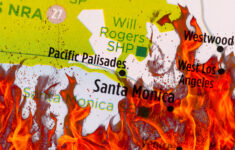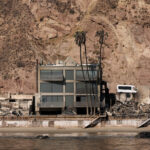A little-known climate threat lurks under our feet: rising groundwater that could release toxic chemicals from more than 132,000 contaminated sites in coastal areas of the U.S. In a first of its kind study, researchers estimated the number of polluted industrial sites and mapped them to areas likely to experience groundwater inundation due to rising seas.
“A lot of people don’t realize that the ocean actually extends under the land in coastal areas, so as the ocean rises, it pushes up the groundwater toward the surface,” said Kristina Hill, an associate professor at the University of California at Berkeley and the lead author of the paper, which was published last week in the journal Earth’s Future.
Factories, fuel stations, military bases and other industrial facilities have left surrounding soil contaminated with carcinogenic chemicals and heavy metals. Some became Superfund sites whose cleanup is overseen by the federal government. Far more are managed by individual states.
When groundwater rises toward the surface, whether from sea level rise or increasingly intense climate-driven storms, those contaminants can leach into it and spread to other waterways, potentially poisoning people and wildlife. Benzene, trichloroethylene (TCE) and other cancer-causing chemicals known as volatile organic compounds can vaporize and enter homes, schools and businesses through sewer pipes or cracks in building foundations.
In 2020, administrators temporarily shuttered a high school in Oakland, Calif., after TCE was discovered in groundwater beneath the building. They feared it would vaporize and contaminate the air inside.
Hill and her colleagues identified 326 Superfund sites vulnerable to groundwater rise in coastal areas. In the San Francisco Bay Area, they found more than 5,000 state-managed toxic sites near the coast and extrapolated that there may be more than 132,000 such sites nationwide. They used elevation as a proxy for groundwater, determining that contaminated sites located below 10 meters (33 feet) are at risk from flooding. California, New York and New Hampshire are most vulnerable due to the size of Superfund sites and coastal areas in those states, according to the researchers.
Analyzing demographic data, the researchers found that contaminated areas subject to groundwater rise are disproportionately located near communities of low-income residents and people of color.
“I think these communities deserve to be at the front of the line to have those soils fully remediated,” said Hill, who studies sea level rise and other climate impacts on urban hydrology.
Jacob Carter is a research director at the Union of Concerned Scientists who has analyzed potential impacts of sea level rise on toxic sites and formerly worked on climate-related Superfund issues at the US Environmental Protection Agency.
“I think this is a very significant study,” said Carter, who was not involved in the research. “If you look at toxic remediation plans, they generally don’t mention sea level rise and other climate change issues and they’re typically not planning for these things.”
Climate-related groundwater rise can scramble the calculus on cleaning up toxic sites. Rehabilitating these locations can drag on for years, if not decades, and the high cost of removing soil has resulted in it being left in place at many sites, covered by an impermeable clay or concrete cap meant to contain the contamination.
Now, though, the threat is from below. “Capping seemed like a great strategy back in the ’80s as it was like putting an umbrella over the chemicals, protecting them from water and from movement,” said Hill. “But now the water is coming up from below, so the umbrella doesn’t work.”
One challenge, according to Hill, is that most states have not mapped coastal groundwater. One state that has is California. In 2022, for instance, regulators ordered the owner of a Bay Area Superfund site slated to be redeveloped as a housing project to assess whether it should change its toxic cleanup plan, given the potential for sea level-related groundwater rise.
“I don’t think too many policymakers are likely aware of the impact of rising groundwater or other climate change impacts on toxic sites or maybe even if these sites exist in their area,” said Carter. “These are some of the most dangerous chemicals known to mankind and we should be doing everything we can in our power to prevent their release.”
Photograph: A gate at the entrance to the former Ciba Geigy chemical plant in Toms River, N.J., is covered with warnings on Tuesday, Jan. 24, 2023, regarding the contaminated area, which is on the Superfund list of the nation’s worst toxic waste sites. (AP Photo/Wayne Parry)





















 Mercury General Gives Reinsurance Update: One or Two Events Still TBD
Mercury General Gives Reinsurance Update: One or Two Events Still TBD  Many Reasons Behind Certain Homes Left Standing After Wildfires
Many Reasons Behind Certain Homes Left Standing After Wildfires  Executives on the Move at Everest Group, Zurich NA, Arch Capital, Plymouth Rock and Intact Financial Corp.
Executives on the Move at Everest Group, Zurich NA, Arch Capital, Plymouth Rock and Intact Financial Corp.  Trump May Be a Net Positive for the Jobs Market, Randstad Says
Trump May Be a Net Positive for the Jobs Market, Randstad Says 



